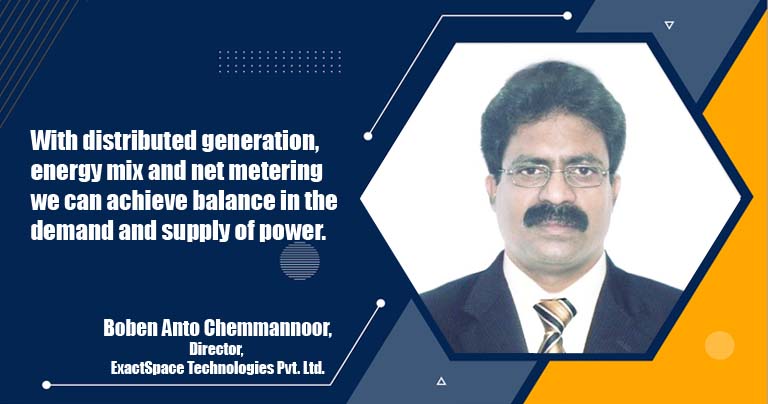Digital substation and distributed energy are key for smooth energy transition
By EPR Magazine Editorial November 26, 2021 3:39 pm IST
By EPR Magazine Editorial November 26, 2021 3:39 pm IST

Discussing the ongoing trends of energy influx with EPR Magazine, Boben Anto Chemmannoor explains the imperativeness of digitalisation of power sector.
How are current energy trends affecting substation automation?
Because of the influx of renewable energy, the concept of distributed generation has become normal. With distributed generation, the substation supply leads to net metering and a balance in power. Because renewable energy generation methods such as wind turbines, micro-hydel, solar, and biomass systems are available in nonlinear generation, site demand has become more flexible. So, to adopt changes on a regular basis, substation automation becomes essential. Moreover, the process of transitioning towards digitalisation has already begun.
What will drive the demand for digitalisation of substations in India?
With the increasing advancements in technology and its upgradation digital relays with fibre optics, substation automation and predictive MTC were developed to ensure reliable operation and maintenance. The remote operation and communication help to ensure better housekeeping with added reliability. Better telemetry leads to better communication and safety. The new MTC procedure based on satellite data and drone technology gives the line clearance and reduces the earth fault defects. The total load management and CCTV monitoring allow us to maintain security aspects along with isolator positions at easy. The new IR-based cameras provide hot spots and corrective actions to reduce catastrophic failures. The utilisation of drones and bio-acids reduce the grass and restrict the drain lines in monsoon and avoid water-logging and make the drains run effectively. The advanced silicone coating on the isolators and bushings avoids the intermittent sparking of corona effects nullify them. As mentioned earlier, due to the distributed generation, net metering and digitalisation it has become easier and safe; this also helps to forecast the demand as well as a generation to plan the activity and make the system more reliable.
Reliable power output and minimum T&D losses make the power sector stronger. What kind of digital products and solutions will help us achieve this?
T&D losses in the system are reduced as the generation and supply points become closer together, based on the GAP in generation and supply. The advanced transformers and various voltage level, distribution also minimise the chances of theft and losses. Meters make it accountable at different voltage levels.
How can digitalisation help smart grid operations and maintenance through substations?Major accountability leads to better action plans and responsibility. The latest accountability utilising artificial intelligence (AI) on the bulk data helps to better utilise the bulk data generated by IoT-based instruments as explained above. As digitalisation helps us to learn from the bulk data and make algorithms to find the relationship matrix, which help us to forecast and take advanced action at the right time. It further helps in reducing the tune and losses. The data from IR cameras, online DGA analysers, and the load management scenarios are able to plan and introduce the predictive MTC policy of substations. Based on the satellite pictures and drone survey, it also checks the vegetation impact and takes corrective measures to make the line reliable. As we, in Exactspace, utilise the data based on the correlation and trends, predicted values can be compared with the best performance and connection parameters. With the proper utilisation of analytics and developed algorithms, predictive models are created and it becomes easier to ensure reliable performance. As AI can easily be used to predict customer behaviour and take corrective action accordingly.
How are the state DISCOMs, utilities, and government agencies responding to digital substation?
Since net metering was being adopted by most DISCOMs, we also witnessed increase in the charging networks for Electric Vehicle (EV). As it already lead to the smart meters, remote metering and bill generation were already initiated and the supply and collection gap has been reduced. The major demand forecast and process optimisation by involving the customer is also practiced by the DISCOMs’. Consumer education, energy utilisation and conservative opportunities were also practiced. Digital substation allows the government agencies to sense the actual consumption and even thought of providing the flexible costing. The renewable utilsation and net-zero production companies were accounted more for utilising the data management. As the learning is available to utilise all the places, we, at Exactspace, also provide the machine learning of data and apply Artificial Intelligence to generate better output.
How far are we leveraging technologies to sustain and overcome threats in digital and automated substations?
It helps to plan, act and control; it also demonstrates the results at micro and macro levels. We can utilise all the statistical tools to get better decision-making. The majority of cyber security guidelines provided by government agencies was implemented on secured hardware and dedicated IP addresses, reducing threats to a bare minimum. As per the system not being able to access any external drives, access is also restricted. Microgrids and batteries were established in some critical areas. As the digital substation is approachable from anywhere, using the approved protocols leads to clearer decision-making on actual data and is able to control the discrepancies. The minimum losses and actual system losses were already recorded, giving the maintenance team direction to act and ensure reliability.
We use cookies to personalize your experience. By continuing to visit this website you agree to our Terms & Conditions, Privacy Policy and Cookie Policy.